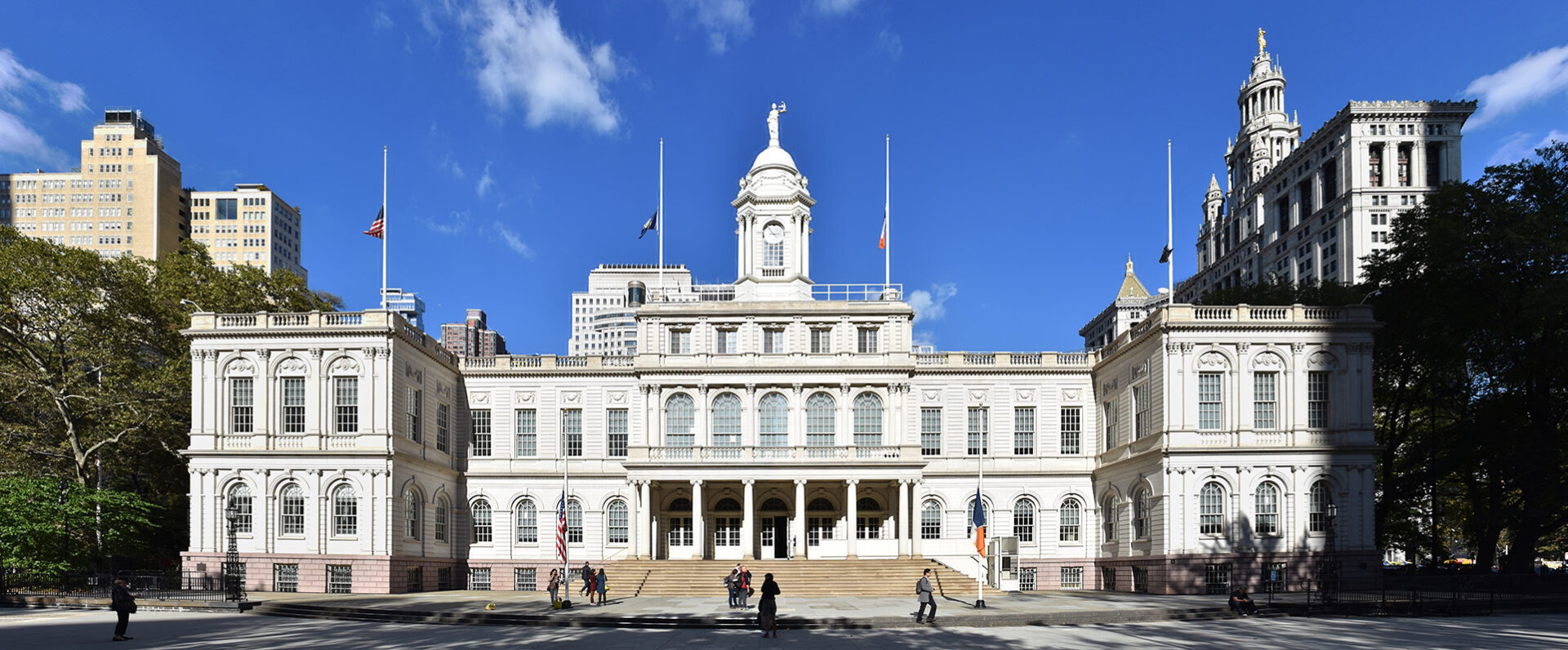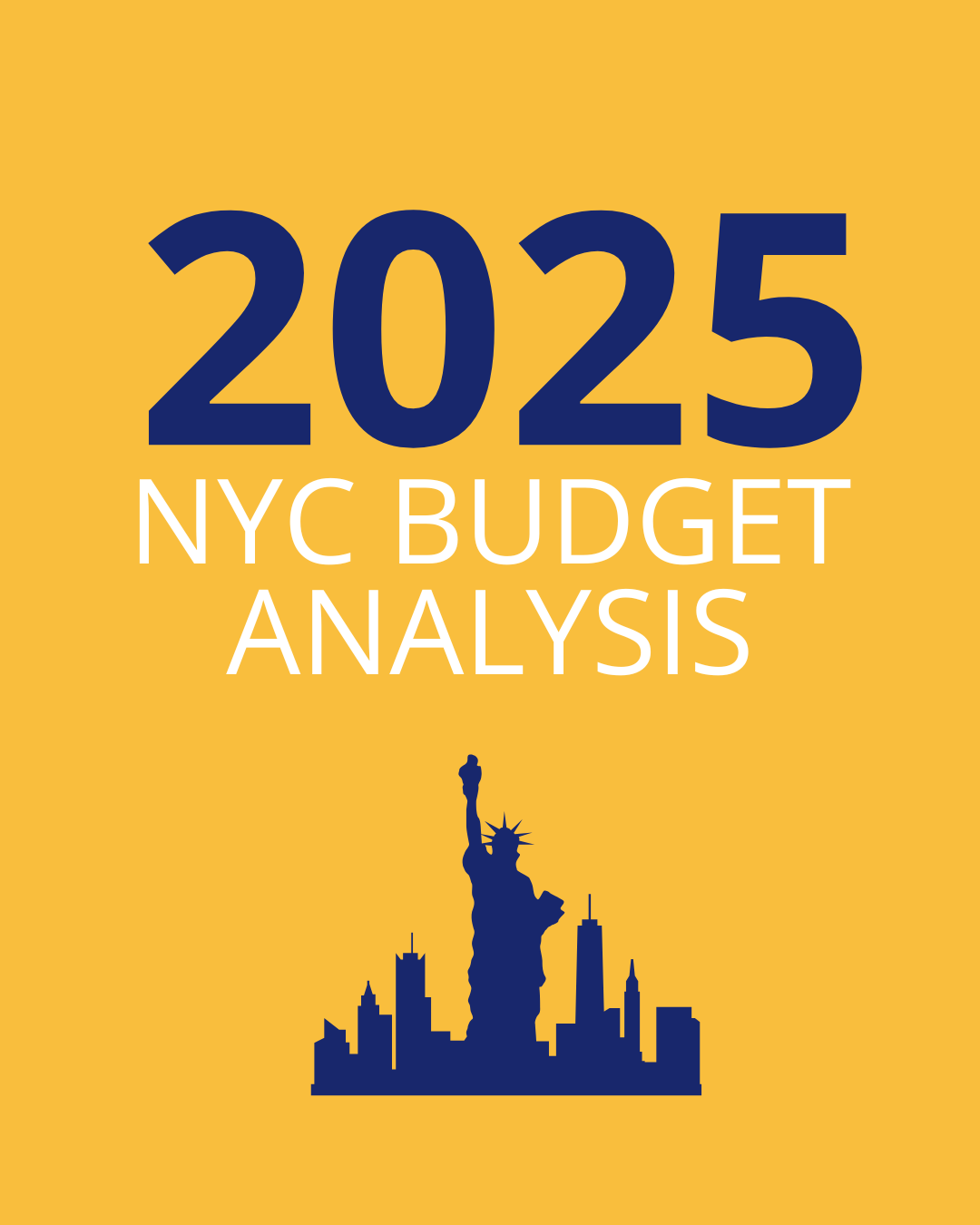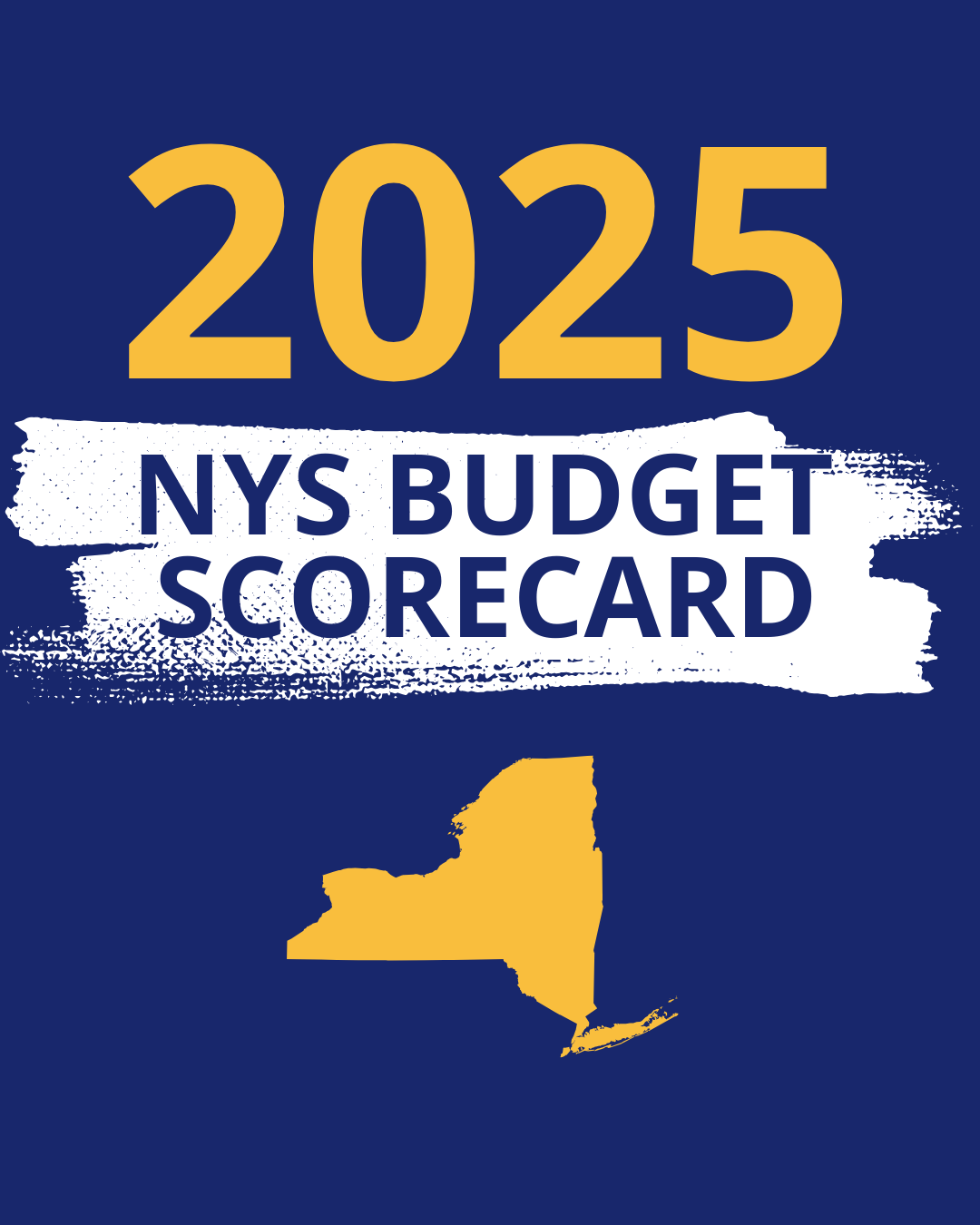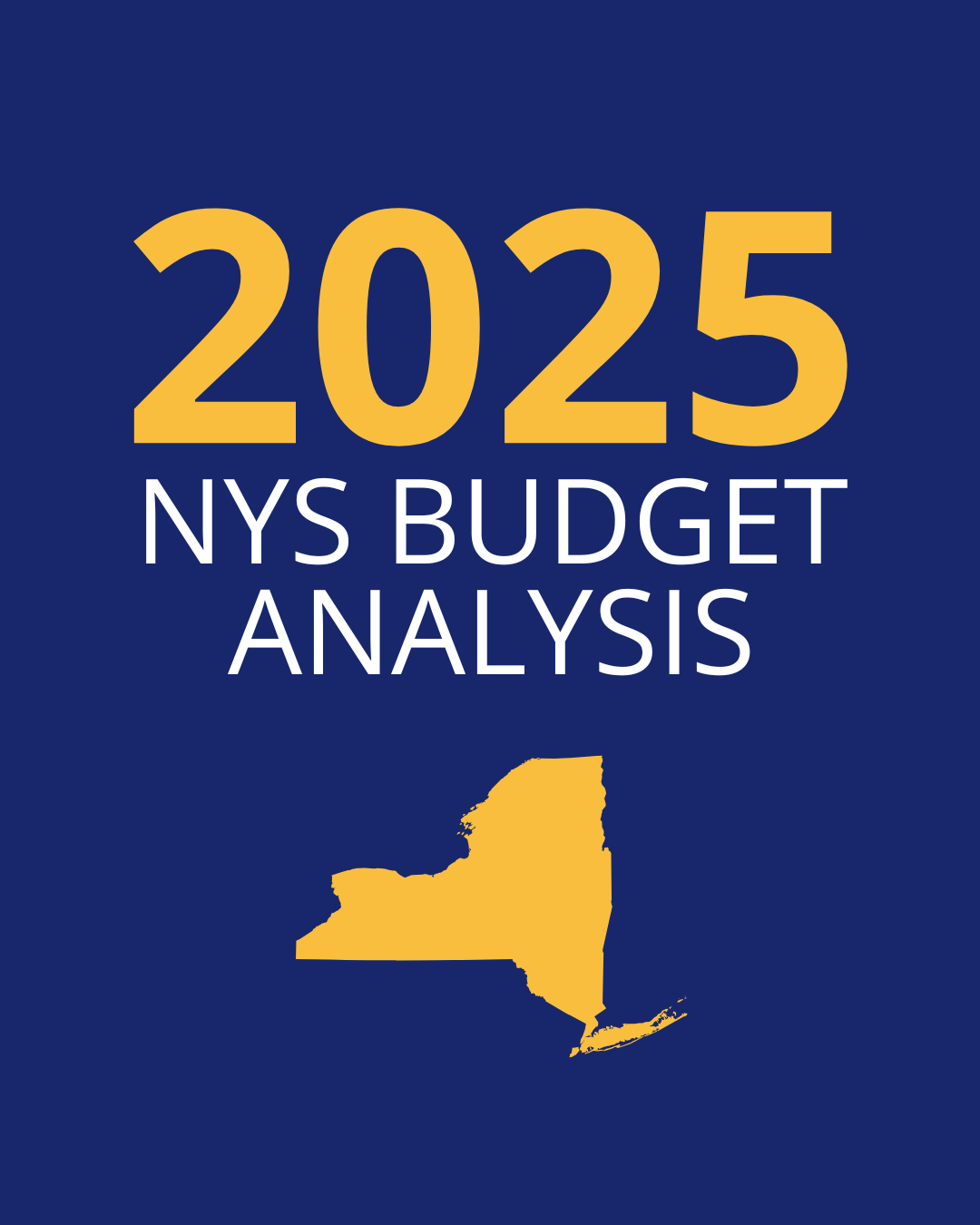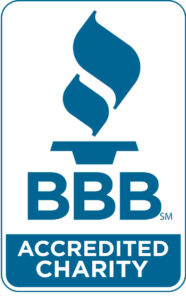On Friday June 30, 2023, the New York City Council passed its budget for fiscal year (FY) 2024. While the $107 billion budget is the largest in the city’s history, it shows a callous shortsightedness on the city’s behalf by slashing millions in funding for human services and failing to meaningfully invest in the workforce that provides these vital services. It exacerbates wage inequality and deepens occupational segregation by failing to make pay equity a reality for the community workforce the city depends on day in and day out. Furthermore, the budget fails to provide for the most vulnerable in the city by cutting funding for education, home-delivered meals for older adults, re-entry services, and other critical programs. Our detailed analysis of the budget reveals:
- Budget cuts across the human services sector;
- A failed attempt to address the inequity faced by the human services workforce;
- De-prioritization of vital programs that New Yorkers rely on.
Budget cuts hurt an already strained human services sector
The city’s FY 2024 budget includes funding reductions across the human services sector, with New York City’s human services agencies1 receiving $860 million less in funding than they did in the fiscal year 2023 modified budget (a reduction of 3.5 percent). These budget cuts impact six of the eight agencies tracked by FPWA (Figure 1).
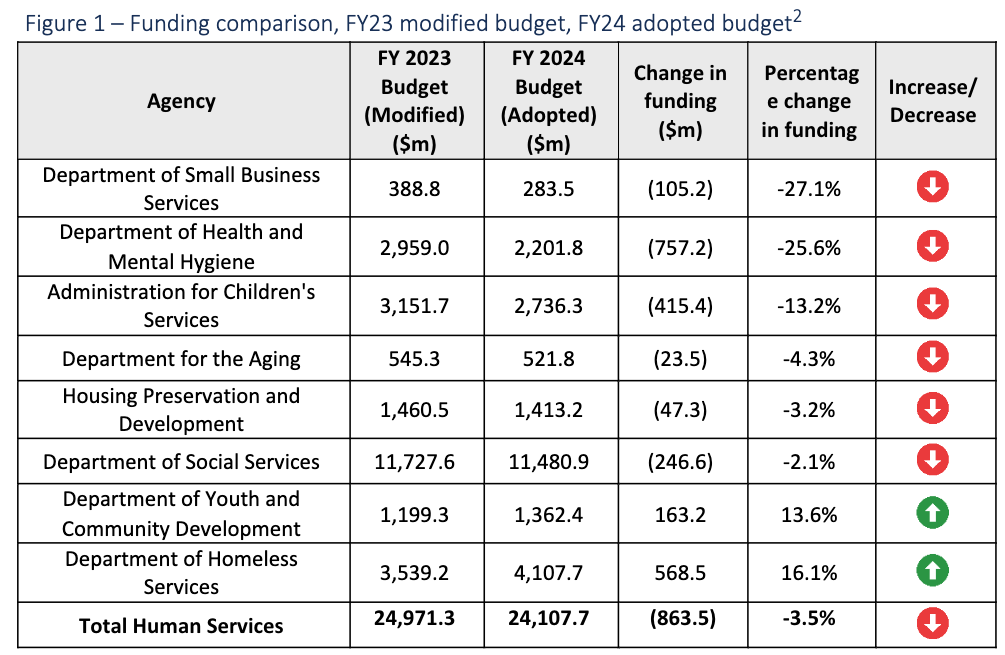
These funding reductions are accompanied by staffing cuts, with staffing levels across these agencies projected to decrease by 522 FTE (full-time equivalent) from 2023 to 2024, and then by another 388 FTE from 2024 to 2025.
These budget reductions and staffing cuts could not come at a worse time for our city’s vital human service agencies. As shown in our 2023 Human Services Funds Tracker, federal and state funding is at the lowest it has been in over a decade. The additional cuts will further limit access to services for New Yorkers in need. The cuts will also put additional strain on an already overworked and underpaid workforce comprised of mostly women of color, who already earn lower wages compared to their white and male counterparts.
The ‘human services wage adjustment’ is a missed opportunity that does not address the structural inequity that contracted human services sector faces
Contracted human services workers provide critical services to millions of New Yorkers each day and deserve to be compensated in accordance with the value they provide to the city. Currently, they make between 20 to 35 percent less in median annual wages and benefits than workers in comparable positions in the government and private sector. Two-thirds of all full-time human services workers had 2019 earnings below the city’s near poverty threshold34.
The adopted FY 2024 budget includes funding for wage adjustments for the contracted human services sector. This consists of a baselined total of $100 million in FY 24 due to an additional $40 million, plus an additional $50 million baselined in FY 25 for a continuing total of $150 million.
This insufficient response does nothing to mitigate the critical problem that the human services workforce is an economic hairsbreadth from the clients they serve.
Contrast this with how the city prioritizes its unionized workforce. In the past year, the city has also agreed to new work agreements, including pay increases, for most of its municipal workforce (United Federation of Teachers (UFT), District Council 37 (DC37), New York Police Department (NYPD)). While these municipal pay increases are well-deserved, the insufficiency and inequity of the contracted human services wage adjustment is stark when compared with these agreements.
Comparison with other workplace arrangements reveals drastic inequity between contracted and municipal workers
The human services wage adjustment provides $150 million for worker wage enhancements. On the other hand, the three recent municipal agreements provide $6.4, $4.4, and $5.5 billion in funding, respectively.
- This equates to 30 to 40 times the amount of funding provided for contracted human services worker wage adjustments. This is despite the fact that the respective municipal agreements cover fewer workers than the contracted human services sector and the already dismal wages of many contracted human services workers.
- For example, a counselor with a bachelor’s degree has a median salary of $39,000 when working in the contracted human services sector. The same counselor has a median pay of $60,000 if working directly for the government—a pay disparity of 31 percent.5

Overall, when considering the amount of funding, the length of the agreement, and the number of workers covered, the funding for human services wage adjustments equates to approximately $600 per worker per year. By comparison, as seen in Figure 3, the NYPD pay increase is more than 50 times that of the wage adjustment for contracted human services workers.
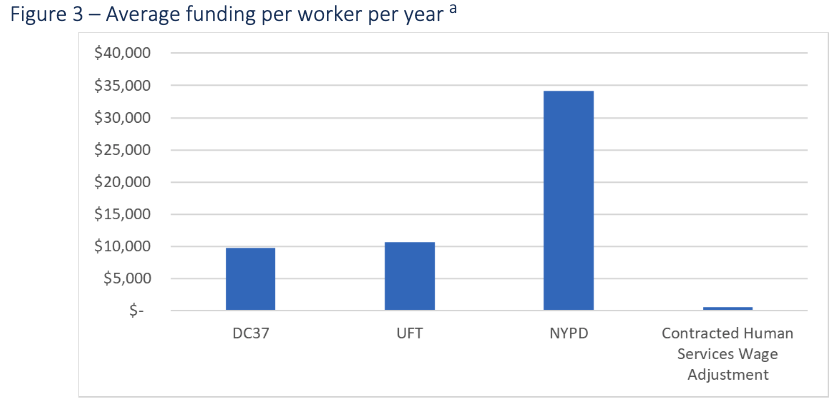
a Calculated by dividing the total funding for each agreement by the number of workers, and the number of years of the agreement.
Further, the wage adjustment fails to provide any longer-term certainty or security for the human services sector and its workers, meaning the contracted human services workers again will face uncertainty as the 2026 budget cycle rolls around. This only exacerbates the dire workforce retention issues the sector is experiencing.
It also does not account for the loss in purchasing power over recent years. On the other hand, the municipal agreements include retroactive pay increases, going back as far as 2016. This leads to a much higher overall pay increase as seen in Figure 4.
![]()
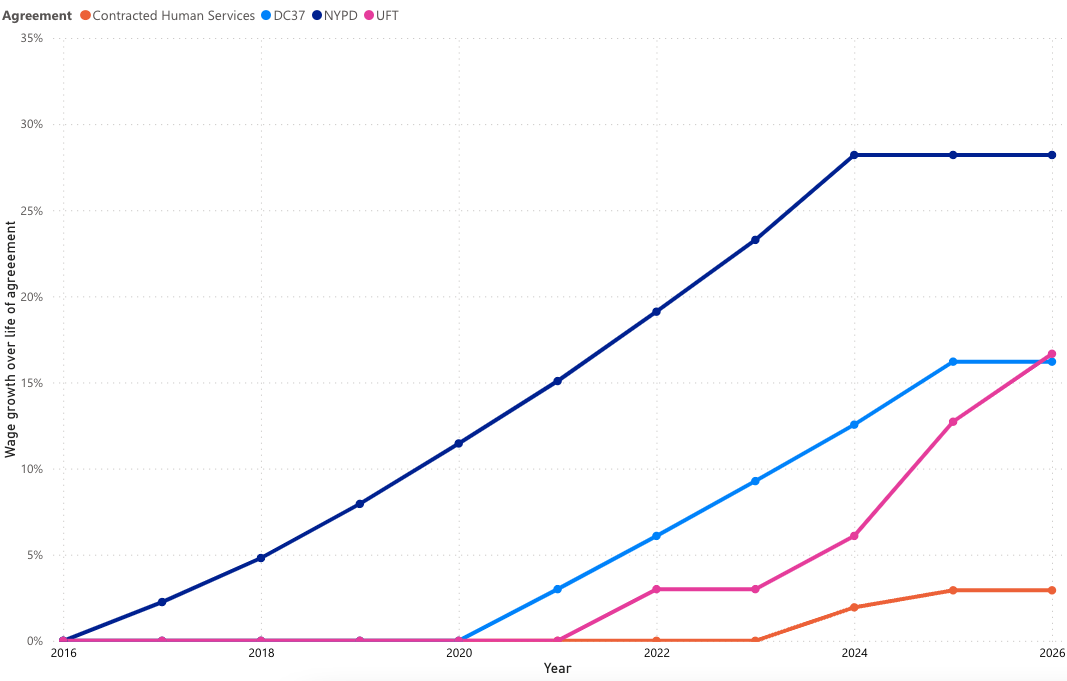
Wage growth % for contracted human services workers has been estimated based on the amount of funding, number of workers, and average wage in the human services sector.
Municipal workplace agreements include additional benefits not afforded to the contracted sector
Finally, the municipal funding agreements not only provide greater cash increases, but they also include benefits beyond simple wage adjustments.
For example, the agreements include supplemental benefits such as:
- UFT – Annual retention payments of $400-$1,000 each year on top of pay increases.
- DC37 – Ratification bonus of $3,000, and a child care trust fund to provide support for members with child care needs.
- NYPD – Neighborhood policing deferential payments of $1,210, holiday pay, and a uniform allowance.
While these benefits and salary increases for government employees are well-deserved, this disparate treatment spotlights how much more needs to be done to support the contracted human services sector. Much like their municipal peers, these essential workers are on the frontlines day-in-and-day-out serving New Yorkers with low-incomes with grace and compassion. The human services workforce consists of 70 percent women, primarily women of color, and is facing dire staff retention challenges due to wages and conditions that often put them one missed paycheck away from the clients they serve. These public servants too could benefit from many of the more bespoke benefits that were afforded to government employees.
The budget fails to prioritize vital services that New Yorkers rely on
While the adopted FY 2024 budget represents an indignity for the city’s human services sector and for New Yorkers who rely on these services, it also represents a significant setback for many other New Yorkers, including parents trying to access 3K, older adults struggling with food insecurity, individuals and families facing eviction, and for those trying to gain economic stability by furthering their education.
No expansion to the city’s 3K for All Program, leaving more New York families without access to 3K
The budget omitted a planned $568 million expansion for free preschool for 3-year-olds, known as “3K.” The city’s new 3K for All program, which began under former Mayor de Blasio, was supposed to be expanded significantly to fulfill its goal of being universal, and parents across the city were promised access to free, high-quality, prekindergarten for their 3-year-old children. But the budget, with no increase in funding to expand 3K for All, makes that impossible. This means more families with young children will be forced to choose between spending thousands on child care or leaving the workforce altogether. Access to free 3K can be a lifeline for parents of young children, especially given the fact that child care is often the highest costs families face. Guaranteeing access for all New York families would be a critical step in addressing the growing child care affordability crisis, but without a sustained commitment from the city to make Universal 3K a reality, parents will continue to face immense challenges accessing affordable early childhood education.
Not enough funding to address capacity issues in legal services
Though this year’s budget deal adds and additional $20 million for housing legal services, bringing the total funding for legal representation in housing proceedings to $206 million in FY 2024 this funding level remains insufficient, falling short by approx. $260 million.6 Fully funding this program would help legal services providers manage their existing 35,000 cases, boost salaries and retain lawyers, and hire additional attorneys and support staff to engage in this vital work.
The funding is attached to a 2017 law that established a right to counsel, or legal advice, for New York City tenants facing eviction in Housing Court or NYCHA administrative proceedings. Through this program, New York City contracts with legal service providers through the Human Resources Administration’s (HRA) Office of Civil Justice (OCJ). While successful in providing some clients with an essential lifeline in housing court, the program has failed to adequately cover the cost of nearly 300,000 annual eviction cases in housing court7, stretching the capacity among legal service providers and forcing them to struggle to meet the current needs of tenants. While the additional $20 million is a welcomed addition, the unwillingness on the city’s behalf to provide the necessary funding to increase capacity in contracting providers demonstrates yet another example of the systemic undervaluing of these vital members of the human services community. Setting a minimum funding level that is not sufficient to address the capacity issues among legal service providers who will need additional funding to recruit, hire, train, and supervise additional staff, dooms New Yorkers to potentially another five years in which their legally enshrined right to counsel may be undermined by overburdened legal representatives and constant delays in proceedings.
Further, while this budget increased funding for public defenders in criminal proceedings by $20.6 million this increase too is insufficient to compensate New York City’s public defenders who are both underpaid and overworked while struggling to preserve the constitutional right to defense for indigent New Yorkers facing criminal proceedings.
Lastly, despite a call by NYC Council Immigration Committee Chair Shahana Hanif and Comptroller Brad Lander for the city to provide $70 million to fund immigration legal services, the city failed to increase immigration legal services funding. This is also despite the record increase in the number of migrants arriving in New York City. While the city has called for both the federal and State government to do their part in providing funding, the city must lead by example and contribute to these vital services.
Meal delivery program for older adults faces cuts, despite rising numbers of older adults living in poverty
$5 million dollars has been cut from the Department for the Aging program that provides home-delivered meals to older adults. Another reduction of $7 million is expected, followed by $5.6 million cut in each of the next three years. The Department for the Aging is already facing funding constraints, as highlighted in our 2023 Human Services Funds Tracker update. Meanwhile, for the 20 percent of New Yorkers over the age of 65, the poverty rate is on the rise. Even with this stark news we know that the official poverty measure itself does not adequately capture the true economic needs of this population and the numbers of those struggling are likely significantly higher.8 The increase in need will only continue to balloon with the anticipated growth in the older adult population. The growth in the older adult population is expected to outpace growth in any other age group within the next few decades, with Baby Boomers making up the second largest living generation in the country.9 With these demographic changes impending, cutting funding from a program dedicated to mitigating food insecurity among this population seems short-sighted and troubling.
Critical support programs for individuals detained at Rikers Island slashed
The adopted FY 2024 budget includes $17 million worth of cuts to classes and re-entry services at Rikers. These programs provide critical support to detained individuals looking to find employment, housing, and connect with loved ones upon release. Classes cover topics ranging from financial literacy, carpentry and plumbing skills, cognitive behavioral therapy, drug relapse prevention, and anger management. The skills learned in these courses are crucial to preventing recidivism. While Mayor Adams is adamant that these services can be provided in house by existing Rikers’ employees, advocates are calling the plan a “pipe dream.” These contracts make up just 1.4 percent of the Department of Correction’s budget, with many of these programs having run in various forms at Rikers for decades, serving to reduce violence and increased structured programming within the jails, and increasing detained individuals’ chances of success upon release into the community.10 Given the otherwise generous funding to law enforcement expressed elsewhere in the budget it is dismaying to see these programs targeted for reduction or elimination.
CUNY schools struggle with budget agreement, even with partial restoration of funding
While FPWA applauds the restoration of a portion of funding to the City University of New York, (CUNY), the next few years of cuts still present danger. Overall, the CUNY system still faces a loss of approximately $35 million. CUNY has dealt with successive cuts over the past few years, resulting in the loss of 235 faculty and staff positions. These additional cuts will likely result in the loss of more faculty, decreasing course offerings and halting the expansion of several successful programs dedicated to attracting and uplifting students, like CUNY Reconnect and Accelerated Study in Associate Programs (ASAP). The CUNY system has long been a vital institution in New York City, generating upward mobility and economic opportunity for working class and low-income New Yorkers. Eighty percent of CUNY students are students of color and 45 percent are first generation college students. This divestment neglects the significant contributions the CUNY institution makes to the city, supplying one third of the city’s public-school teachers and half of the city’s nurses. Eighty percent of CUNY graduates remain in New York upon graduation, paying roughly $4 billion in state income tax each year.11
Looking forward
Despite the critical analysis of the areas where this budget falls well short of what the people of the City of New York deserve, FPWA remains focused on continuing our work to advance racial and economic equity in our city. FPWA remains committed to ensuring that New Yorkers with low incomes have the necessary income and potential for building assets that enable them to thrive; to ensuring an equitable, just, and appropriately resourced human services sector that is responsive to the needs of New Yorkers; and to dismantling the unjust structures and systems that inhibit New Yorkers’ rights to dignity and power. We look forward to working together with the Mayor and City Council, as well as our nonprofit partners and member organizations, to make progress on these important issues.
Footnotes
1 When we refer to New York City’s human services agencies, we are referring to the Administration for Children’s Services (ACS), Department of Social Services (DSS), Department of Youth and Community Development (DYCD), Department for the Aging (DFTA), Department of Health and Mental Hygiene (DOHMH), Department of Homeless Services (DHS), Housing Preservation and Development (HPD), and Small Business Services (SBS).
2 Funding amounts from Expense, Revenue, Contract Budget for New York City for Fiscal Year 2024 (page 2E)
3 The near-poverty threshold is an alternate measure of economic need calculated by the NYC Government. Further information can be found at https://www.nyc.gov/site/opportunity/poverty-in-nyc/poverty-measure.page.
4 The Case for Ending Poverty Wages For New York City’s Human Services Workers. Center for New York City Affairs – The New School. 2022. http://www.centernyc.org/reports-briefs/the-case-for-ending-poverty-wages-for-new-york-citys-human-services-workers
5 Ibid.
6 What Would It Take To Fully Fund Right To Counsel For NYC Tenants? City Limits. 2023. https://citylimits.org/2023/04/10/what-would-it-take-to-fully-fund-right-to-counsel-for-nyc-tenants/
7 Statewide Landlord-Tenant Eviction Dashboard. NYcourts.gov. https://ww2.nycourts.gov/lt-evictions-33576
8 Measuring Poverty and the True Cost of Living in the U.S. FPWA. 2022. https://www.fpwa.org/wp-content/uploads/2022/09/MEASURING-POVERTY-AND-THE-TRUE-COST-OF-LIVING-IN-THE-U.S._2022.pdf
9 NYC set to slash millions in home delivered meals program for seniors. Gothamist. 2023. https://gothamist.com/news/nyc-set-to-slash-millions-in-home-delivered-meals-program-for-seniors
10 Mayor Adams cuts classes and re-entry services at Rikers to save $17 million in NYC budget. Gothamist. 2023. https://gothamist.com/news/mayor-adams-cuts-classes-and-re-entry-services-at-rikers-to-save-17-million-in-nyc-budget
11 Cuts to CUNY: An analysis of financial risks posed by cuts to the City University of New York in NYC’s FY 2024 Executive Plan. New York City Comptroller Brad Lander. 2023. https://comptroller.nyc.gov/reports/cuts-to-cuny/#:~:text=CUNY’s%20Overall%20Budget%20and%20Financial,(i.e.%202%20year)%20Colleges

